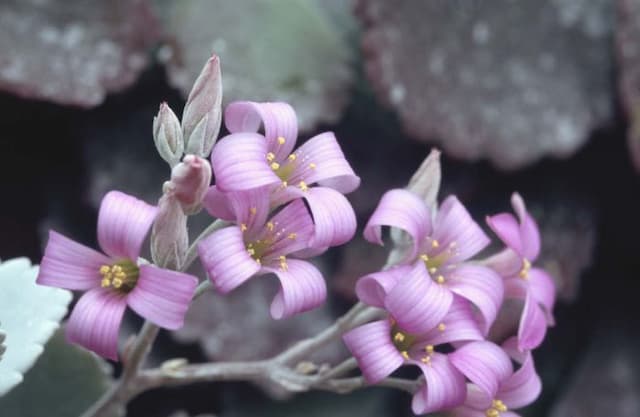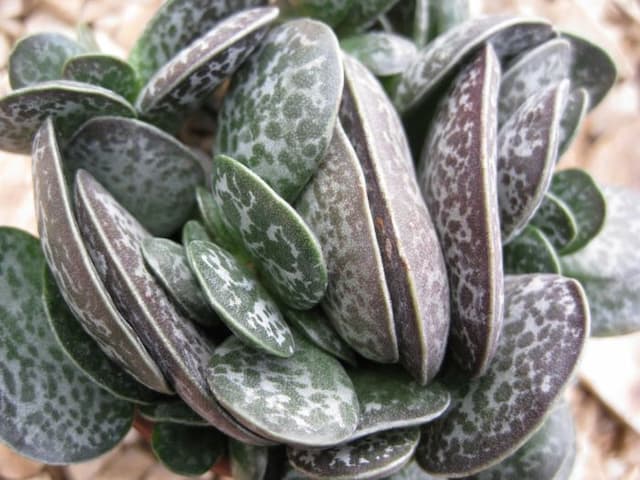Jelly Bean Plant Sedum × rubrotinctum

ABOUT
The Sedum × rubrotinctum, commonly known as Jelly Bean Plant or Pork and Beans, is a succulent plant characterized by its chubby, pebble-like leaves. These leaves are quite distinctive and are the most striking feature of the plant. In color, they exhibit a gradient of shades from green to red, with the tips often turning a bright, reddish hue, particularly when the plant is exposed to plenty of sunlight, creating a visual semblance to jelly beans or pork and beans which gives the plant its nickname. The fleshy leaves have a glossy texture and are tightly clustered together, growing on stems that tend to sprawl outwards as the plant matures. The overall form of the plant is a spreading mound with a lush, bushy appearance due to the dense leaf coverage. During certain times of the year, the plant may produce small, star-shaped flowers that add an additional dimension of interest. These flowers can be yellow or pink, and they emerge in small clusters above the foliage, offering a contrast to the colorful leaves beneath. The Jelly Bean Plant's ability to store water inside its leaves is a functional characteristic that enables it to thrive in arid environments. This water storage capability also means that the leaves have a certain plumpness and firm texture, which is important to the plant's overall resilient nature. Despite its hardy constitution, the Jelly Bean Plant is also esteemed for the ornamental appeal of its cheerful and unique leaf coloration.
About this plant
 Names
NamesFamily
Crassulaceae.
Synonyms
Jelly Bean Plant, Pork And Beans Plant, Christmas Cheer, Banana Cactus, Brown Bean, Chinese Burro's Tail.
Common names
Sedum × rubrotinctum.
 Toxicity
ToxicityTo humans
The common name of Sedum × rubrotinctum is Jelly Bean Plant. This plant is considered to have low toxicity to humans. However, if ingested, it could potentially cause minor symptoms such as vomiting or diarrhea. It is important to avoid ingesting any part of the plant, especially for children and individuals with sensitivities.
To pets
Jelly Bean Plant is known to be toxic to pets, particularly cats and dogs. If pets ingest this plant, they could experience vomiting, diarrhea, and lethargy. In severe cases, ingestion can lead to more serious symptoms requiring veterinary attention. Pet owners should keep this plant out of reach of their animals to prevent any accidental poisoning.
 Characteristics
CharacteristicsLife cycle
Perennials
Foliage type
Evergreen
Color of leaves
Green
Flower color
Yellow
Height
1 foot (30 cm)
Spread
1 foot (30 cm)
Plant type
Succulent
Hardiness zones
9
Native area
Mexico
Benefits
 General Benefits
General Benefits- Low Maintenance: It requires minimal care, making it perfect for beginner gardeners or those with a busy lifestyle.
- Drought-Resistant: It is highly tolerant of drought, requiring little water once established, which conserves water and reduces the need for frequent watering.
- Attractive Foliage: The jelly bean-like leaves provide an interesting shape and color to gardens, adding aesthetic appeal.
- Ground Cover: Its spreading habit makes it a good ground cover, reducing soil erosion and suppressing weeds.
- Easy to Propagate: It can be easily propagated from leaves or cuttings, making it simple to expand your garden or share with others.
- Seasonal Interest: The leaves can change color throughout the seasons, from green to red, adding variety throughout the year.
- Suitable for Containers: It thrives in pots and containers, which is ideal for those with limited garden space or who want to decorate patios and balconies.
- Attracts Pollinators: During its flowering period, it can attract bees and other pollinators, supporting local ecosystems.
- Resilient: It is resistant to pests and diseases, reducing the need for chemical treatments and keeping your garden healthier.
- Tolerant to Poor Soil: It can grow in less than ideal soil conditions, including rocky or sandy soils, reducing the need for soil amendments.
 Medical Properties
Medical PropertiesThis plant is not used for medical purposes.
 Air-purifying Qualities
Air-purifying QualitiesThis plant is not specifically known for air purifying qualities.
 Other Uses
Other Uses- Sedum × rubrotinctum, commonly known as Jelly Bean Plant, is sometimes used in creating green roofs because of its hardy nature and drought-resistance.
- The Jelly Bean Plant can be employed as a ground cover in areas with minimal foot traffic due to its low-growing habit and ability to spread.
- In craft projects, the succulent's colorful leaves can be arranged to create living wreaths or other decorative items, often for festive occasions.
- Jelly Bean Plant can be used as a natural pest deterrent; its thick foliage is said to be disliked by some common garden pests.
- This succulent is sometimes used in spiritual or feng shui practices within the home to add a touch of greenery and to supposedly bring positive energy.
- The Jelly Bean Plant can act as a living mulch, maintaining soil moisture and temperature while reducing weed growth with its dense coverage.
- In landscape design, the plant is often used to add texture and bursts of color due to its distinctive chubby, red-tipped leaves.
- It is ideal for container gardening, enhancing patios and balconies with its low maintenance and aesthetic appeal.
- Used in educational projects, the Jelly Bean Plant can teach children about plant propagation, as it easily reproduces from leaf cuttings.
- During festive seasons, the Jelly Bean Plant is often used as a natural decoration alongside pumpkins and corn stalks for autumn displays.
Interesting Facts
 Feng Shui
Feng ShuiThe Jelly Bean Plant is not used in Feng Shui practice.
 Zodiac Sign Compitability
Zodiac Sign CompitabilityThe Jelly Bean Plant is not used in astrology practice.
 Plant Symbolism
Plant Symbolism- Resilience: Sedum × rubrotinctum, commonly known as Jelly Bean Plant, is known for its ability to thrive in harsh conditions. Its plump, water-retaining leaves symbolize the ability to adapt and survive in challenging environments.
- Perseverance: The Jelly Bean Plant's robust growth and tendency to spread easily reflect the quality of persistence and determination in overcoming obstacles.
- Joy: With its brightly colored leaves that can resemble little candies, the Jelly Bean Plant represents cheerfulness and brings a playful, joyful energy to surroundings.
- Healing: Given its succulent nature, the Jelly Bean Plant is often associated with healing properties and the restorative power of nature.
- Protection: Succulents in general are sometimes considered symbols of protection due to their sturdy and self-sustaining nature, and the Jelly Bean Plant is no exception.
- Abundance: The Jelly Bean Plant's propensity to grow abundantly and easily propagate from fallen leaves symbolizes wealth, prosperity, and abundance.
 Water
WaterThe Pork and Beans plant, commonly known as Jelly Bean Plant, should be watered thoroughly once the soil is completely dry. In general, watering every 7 to 10 days during the active growing season (spring and summer) is sufficient, while in the winter, reduce watering to once a month. When watering, soak the soil with approximately one gallon of water, ensuring that excess water drains out, to mimic their natural arid conditions. Do not let the plant sit in water as it can cause root rot. Always check the top inch of soil for dryness before watering again.
 Light
LightThe Jelly Bean Plant thrives best in bright light conditions. It should be placed in a spot where it can receive at least 6 hours of sunlight daily, such as a south-facing window. If the light is too low, the plant may stretch and lose its compact form, so make sure it gets plenty of sunlight without being exposed to harsh, direct afternoon sun, which can scorch the leaves.
 Temperature
TemperatureJelly Bean Plants prefer warmer temperatures and do well in a range between 65°F and 75°F. They can tolerate temperatures down to around 40°F but should not be exposed to frost or freezing conditions. The ideal temperature should avoid both extremes and provide a stable environment to ensure healthy growth.
 Pruning
PruningPrune Jelly Bean Plants to maintain shape and encourage bushier growth. It's best to prune in the spring at the beginning of their growing season. Remove any leggy or dead stems as well as spent flowers. Pruning every few months or as needed will also help to remove any damaged or diseased parts of the plant and promote a healthier structure.
 Cleaning
CleaningAs needed
 Soil
SoilFor the Jelly Bean Plant, a well-draining soil mix is crucial, ideally with a pH between 6.0 and 7.5. A recommended soil recipe includes 1 part potting soil, 1 part coarse sand, and 1 part perlite or pumice to ensure adequate drainage and aeration. Regular testing and amendments can maintain the pH within the desired range.
 Repotting
RepottingThe Jelly Bean Plant should be repotted every 2-3 years or when it outgrows its current container. It's best to repot during the spring or early summer when the plant is actively growing.
 Humidity & Misting
Humidity & MistingJelly Bean Plants prefer low to moderate humidity levels, consistent with their native arid environments. They thrive in typical indoor humidity levels, so no special adjustments are necessary.
 Suitable locations
Suitable locationsIndoor
Place Jelly Bean Plant in bright, indirect light, and well-draining soil.
Outdoor
Jelly Bean Plants love full sun to partial shade and well-draining soil.
Hardiness zone
9-11 USDA
 Life cycle
Life cycleSedum × rubrotinctum, commonly known as Jelly Bean Plant or Pork and Beans, begins its life cycle when seeds germinate in spring or early summer, given adequate warmth and moisture. The seedlings develop fleshy leaves and a shallow root system in a rosette pattern, and within a few weeks to months, they establish a mat-forming growth habit. The plant enters a vegetative stage where stems lengthen, and leaves thicken to store water, adapting to its succulent nature which is crucial for survival in its native arid environments. During spring or early summer, the Jelly Bean Plant may produce clusters of small, star-shaped flowers if provided with sufficient light, initiating its reproductive phase. After pollination, often by insects, the flowers develop into small, capsule-like fruits containing seeds, which, when mature, are dispersed by wind, water, or animals, allowing for the spread of the plant. Throughout its life, Sedum × rubrotinctum may also propagate vegetatively; leaves that fall to the ground can root and grow into new plants, ensuring the continuation of its life cycle.
 Propogation
PropogationPropogation time
Spring-Summer
Sedum × rubrotinctum, commonly known as Jelly Bean Plant or Pork and Beans, can be effectively propagated through leaf cuttings, one of its most popular methods. To propagate through leaf cuttings, gently twist a leaf from the stem of a healthy Jelly Bean Plant, ensuring that the entire leaf is intact without leaving any part on the stem. After obtaining the leaf, allow it to dry and callous over for a few days, which helps prevent rot when planted. Next, place the calloused leaf on top of well-draining soil, misting lightly to keep the soil moist but not waterlogged. Roots and a new plantlet will typically emerge from the base of the leaf within a few weeks. This process is often done in the warmer months when the plant is actively growing, ensuring better success rates.









